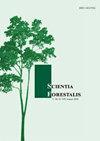在巴西北里奥格兰德州种植的木材能源的无性系是否会受到间距的影响?
IF 0.4
4区 农林科学
Q4 FORESTRY
引用次数: 1
摘要
K. A. G., & Lima, J. L. P.,(2021)。间距对巴西北部的产量有影响吗?林业科学,49 (131),e3641。https://doi.org/10.18671/scifor.v49n131.25摘要造林处理对桉树木材的生产力和质量有显著影响。研究了不同株距对巴西北里奥格兰德州尾叶桉(Eucalyptus urophylla x Eucalyptus brassiana) 4.5岁无性系木材产量和木材能的影响。测量三棵树的体积并采集盘,在每棵树的10个位置(0%、胸径、2.5%、25%、37.5%、50%、67、5%、75%、85.5%和100%)采集和去除盘,间距为:3 m × 0.5 m;3米× 1.5米;3米× 3米;3米× 5米和3米× 6.5米),共15棵树和150个圆盘。研究了10 ~ 50月龄的木材产量、不同间距下的基本密度和能量产量。在所有评价中,3 m x 1.5 m的间距提供了更大的体积产量和平均年增量,而3 m x 3 m的间距促进了基本木材密度的增加,相对于最小间距增加了10%,相对于最大间距增加了6%。对于能源生产,不同的间距之间没有显著差异。因此,在考虑木材的基本密度时,中等比例的间距更合适,但是,如果目标是本文章由计算机程序翻译,如有差异,请以英文原文为准。
Does spacing affect the production of clones for wood energy planted in the state of Rio Grande do Norte, Brazil?
K. A. G., & Lima, J. L. P. E., (2021). Does spacing affect the production do Norte, Brazil? Scientia Forestalis , 49 (131), e3641. https://doi.org/10.18671/scifor.v49n131.25 Abstract Silvicultural treatments can significantly influence the productivity and quality of eucalyptus wood. This work aimed to evaluate the influence of plant spacing on the production of wood and wood energy of a clone of Eucalyptus urophylla x Eucalyptus brassiana , at 4.5 years of age, planted in the state of Rio Grande do Norte, Brazil, under different spacing. The volume was measured and discs were collected from three trees, discs were collected and removed in 10 positions of each tree (0%, DBH, 2.5%, 25%, 37.5%, 50%, 67, 5%, 75%, 85.5% and 100%) in the following spacing: 3 m x 0.5 m; 3 m x 1.5 m; 3 m x 3 m; 3 m x 5 m and 3 m x 6.5 m), totalling 15 trees and 150 discs. The wood production from 10 to 50 months of age, the basic density and energy production in the different spacing were studied. The 3 m x 1.5 m spacing provided greater volumetric production and average annual increment in all evaluations, while the 3 m x 3 m spacing promoted an increase in basic wood density of 10% in relation to the smallest spacing and 6% in relation to the largest spacing. For energy production, no significant difference was identified between the spacing. Thus, spacing in medium proportions are more appropriate when considering the basic density of the wood, but, if the objective is
求助全文
通过发布文献求助,成功后即可免费获取论文全文。
去求助
来源期刊

Scientia Forestalis
Agricultural and Biological Sciences-Forestry
CiteScore
1.00
自引率
0.00%
发文量
39
期刊介绍:
Scientia Forestalis is a scientific publication of the IPEF – Institute of Forest Research and Studies, founded in 1968, as a nonprofit institution, in agreement with the LCF – Department of Forest Sciences of the ESALQ – Luiz de Queiroz College of Agriculture of the USP – São Paulo University. Scientia Forestalis, affiliated to the ABEC – Brazilian Association of Scientific Publishers, publishes four issues per year of original papers related to the several fields of the Forest Sciences.
The Editorial Board is composed by the Editor, the Scientific Editors (evaluating the manuscript), and the Associated Editors (helping on the decision of acceptation or not of the manuscript, analyzed by the Peer-Reviewers.
 求助内容:
求助内容: 应助结果提醒方式:
应助结果提醒方式:


